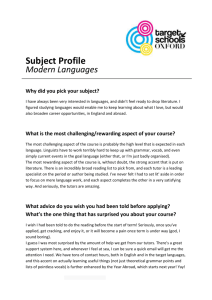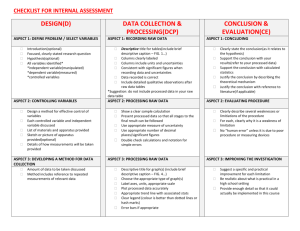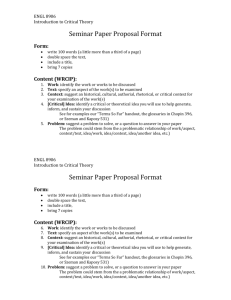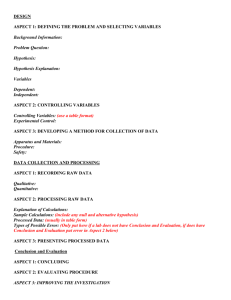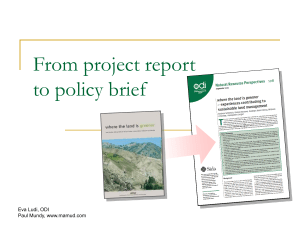Assessment Schedule – 2012
advertisement
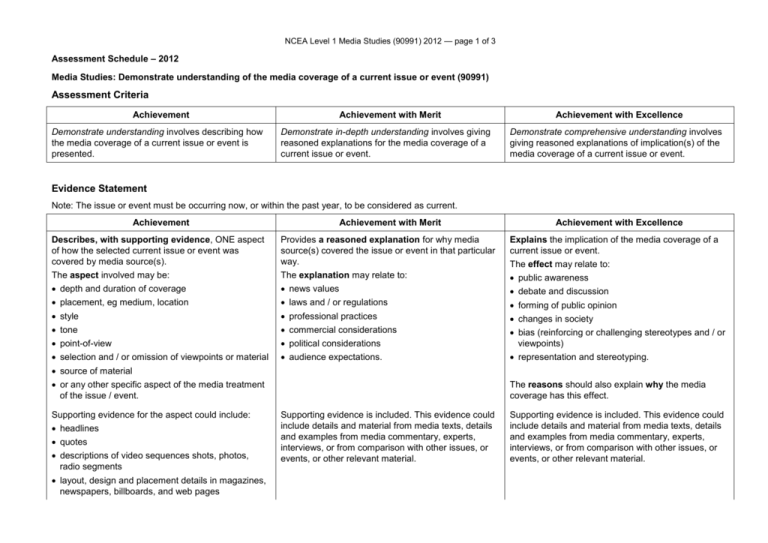
NCEA Level 1 Media Studies (90991) 2012 — page 1 of 3 Assessment Schedule – 2012 Media Studies: Demonstrate understanding of the media coverage of a current issue or event (90991) Assessment Criteria Achievement Demonstrate understanding involves describing how the media coverage of a current issue or event is presented. Achievement with Merit Demonstrate in-depth understanding involves giving reasoned explanations for the media coverage of a current issue or event. Achievement with Excellence Demonstrate comprehensive understanding involves giving reasoned explanations of implication(s) of the media coverage of a current issue or event. Evidence Statement Note: The issue or event must be occurring now, or within the past year, to be considered as current. Achievement Achievement with Merit Achievement with Excellence Describes, with supporting evidence, ONE aspect of how the selected current issue or event was covered by media source(s). Provides a reasoned explanation for why media source(s) covered the issue or event in that particular way. Explains the implication of the media coverage of a current issue or event. The aspect involved may be: The explanation may relate to: depth and duration of coverage news values public awareness placement, eg medium, location laws and / or regulations style professional practices tone commercial considerations point-of-view political considerations bias (reinforcing or challenging stereotypes and / or viewpoints) selection and / or omission of viewpoints or material audience expectations. representation and stereotyping. The effect may relate to: debate and discussion forming of public opinion changes in society source of material or any other specific aspect of the media treatment of the issue / event. Supporting evidence for the aspect could include: headlines quotes descriptions of video sequences shots, photos, radio segments layout, design and placement details in magazines, newspapers, billboards, and web pages The reasons should also explain why the media coverage has this effect. Supporting evidence is included. This evidence could include details and material from media texts, details and examples from media commentary, experts, interviews, or from comparison with other issues, or events, or other relevant material. Supporting evidence is included. This evidence could include details and material from media texts, details and examples from media commentary, experts, interviews, or from comparison with other issues, or events, or other relevant material. NCEA Level 1 Media Studies (90991) 2012 — page 2 of 3 statistics of coverage use of colour and text reference to the actions or press releases of particular media personalities use of social networking sites use of sound bites and vox pops repeated use of particular images or terminology evidence relating to the omission of groups or ideas. Partial example: Partial example: Partial example: Placement is determined by how newsworthy a story is. The placement is very important to the article, as it determines how likely it is to be seen and read. An article on the front page is far more likely to be seen and read than an article in section B4. The bigger the article and closer to the front page, the more important and newsworthy an article is thought to be. Because the Wellywood story focussed on a local issue and drew on the celebrity factor of film-making in New Zealand’s capital, it was a narrative that was worthy of many news sources. News values were central to the success or otherwise of the “Wellywood” story. The biased views of journalists towards the intended “Wellywood” sign means that a balanced debate was not put forward in media coverage. Wellington airport received minimal coverage or was made to look like the “bad guys”. Negative media comments such as “tacky” (TVNZ online post) postioned the media debate as negative towards the “Wellywood” sign. On the 21st May 2011, an article came out about the “Wellywood” sign. It was on the front page of The Dominion Post, with a large heading and a photo. The photo was of Steve Fitzgerald, CEO of Wellington Airport, holding up a photo of the proposed “Wellywood” sign. The heading said in big, bold lettering, “Wellywood gets the sign off.” The article confirmed the sign was going up on Miramar’s hill. The article held the news values: timeliness (recent) and proximity (how close the event was to readers). The “Wellywood” story was current and had the news value: proximity because it happened in New Zealand’s capital. As the article had these two news values, the placement was on the front page. It took up half of the front page, and was therefore the lead story all because of its news values. Because of the changing nature of an event and therefore news values, stories can go from being on section A3 of the newspaper to section B4. On stuff.co.nz on the 23 May at 9:30 am, an article was released about a protest that occurred at Wellington airport in relation to the “Wellywood” sign. It was the third heading on the website and held the news values: timeliness, proximity, and conflict. It was therefore newsworthy and held a lot of impact. An article about a tornado, which occurred overseas and claimed 31 lives, was the fourth heading on the site. The reason for the tornado not having a higher heading than the “Wellywood” sign was because it did not have the news value: proximity. On stuff.co.nz at 11:30 am on the 23 May, the tornado had moved up to the third heading, and “Wellywood” had moved down to the fourth heading. This was because the tornado story had been updated and there were now 91 people dead, giving it more negativity and impact than the issue over the proposed “Wellywood” sign, and making it more newsworthy. Once the move was made to put the sign on hold, an editorial in The Dominion Post, suggested that it was a “victory for common sense”. This obvious bias created through the media coverage in terms of selection and omission of material and viewpoints in relation to the “Wellywood” sign, swayed the general public’s perception of the entire issue. What was originally an intention to use the sign to celebrate and advertise our global film industry to people arriving in the capital, became a national debate about “Kiwi originality” played out in the media. Because there were so many negative viewpoints presented in the media, such as in The Dominion Post and on Campbell Live, the issue became controversial. The ongoing debate, which the media weighed in on, combined with social media, letters to the editor, and talkback radio, created the illusion that the “Wellywood” sign was a huge deal when it wasn’t. Colin Peacock, in a Media Watch episode, called the media coverage a “mountain out of a molehill”. NCEA Level 1 Media Studies (90991) 2012 — page 3 of 3 Not Achieved N1 Achievement N2 Merit Excellence A3 A4 M5 M6 E7 E8 Incomplete coverage of aspect. Incomplete coverage of aspect. ONE aspect is described in some detail. ONE aspect is described in detail. ONE aspect is explained in some detail. ONE aspect is explained in detail. ONE aspect is explained in detail, drawing valid conclusions from evidence. ONE aspect is explained in detail, drawing valid and at times insightful conclusions from evidence. Little understanding of the media coverage shown in description. Shows some understanding of the media coverage. Shows an understanding of the media coverage. Shows a sound understanding of the media coverage. Shows a sound understanding of the media coverage. Shows a sound understanding of the media coverage. Shows convincing understanding of the media coverage. Shows convincing understanding of the media coverage. May attempt to give reasons for the media coverage, but they are oversimplified, or weak. Gives some sound reason for the media coverage. Gives sound reason for the media coverage. Reason given for the media coverage is thoughtful. Reason given for the media coverage is insightful. Insufficient evidence used. Insufficient evidence used. Sufficient relevant evidence provided. Detailed and relevant evidence provided. Detailed and relevant evidence provided. Detailed and judicious evidence provided. Detailed and judicious evidence provided. Sufficient relevant evidence provided. N0/ = No response; no relevant evidence. Judgement Statement Score range Not Achieved Achievement Achievement with Merit Achievement with Excellence 0–2 3–4 5–6 7–8 Codes C = Description of aspect of coverage in media source(s), with supporting evidence. R = Reason(s) provided to explain why media source(s) covered issue / event that way. SW = So what? Discussion of the implication(s), effect(s) of, and / or conclusion(s) drawn from, specific media coverage of event / issue.

